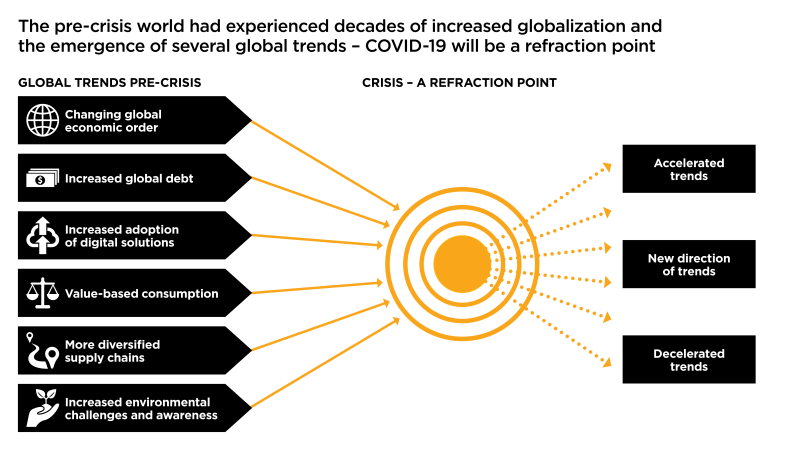The pandemic will undoubtedly have long-lasting economic and social effects and change the direction of the international business landscape. It is also clear that we are heading toward a unique refraction point: some global trends developing before the crisis will accelerate, others will abate.
Although the world is still far away from shaking off the effects of Covid-19, there is no question that ‘recovery’ will not mean returning to the previous normality. Now is the time to face the realities of a pre-pandemic and post-pandemic world.
THE WORLD AS WE KNEW IT – AND WHY IT WILL NEVER BE THE SAME
By the start of the 21st century the world had grown increasingly globalised and interconnected in terms of trade, movement of people, goods, and exchange of ideas.
From 2009 to 2019 the world’s GDP had grown by more than 60 per cent. But as globalisation created more wealth, it also caused interdependencies, inherent systemic risks and vulnerability to crisis.
The world has dealt with previous crises including the SARS and Ebola epidemics, the global financial crisis and wars. Nonetheless, the current pandemic is unique in terms of scale, impact and response. Almost every country and industry have been impacted and the simultaneous disruption of both supply and demand is unprecedented.
Never before has close to one third of the human population experienced lockdowns and curfews nor have governments been forced to provide such large stimulus packages or tackle such rapidly rising levels of unemployment.
THE REFRACTION POINT
Trends and transformations that were underway before the crisis will inevitably change. They will accelerate, slow down or take a completely new direction. While demand may return to pre-pandemic levels when restrictions are lifted, or near at least, consumer behaviour is likely to undergo some form of permanent change.
Digital solutions such as online shopping and web-based education are two trends that have accelerated by several years, in the space of just a few months. The long-term trajectory of other trends such as sustainability is less clear. Will green stimulus packages issued in the wake of Covid-19 create a milestone in the battle against climate change? Or will cash-strapped companies with enough worries about their bottom-line abandon sustainability goals?
Managing this uncertainty will be a critical challenge for Swedish companies. Continued disruption is likely to bring new challenges that are difficult to predict and more complex than the world has faced before. A good way to navigate this uncertainty and mitigate risks is to adopt scenario planning tailored to every business need.
The scenario approach should also consider a few geopolitical questions including the shape of recovery, the direction of globalisation and how major regions will recover from the crisis. While this article explores the extreme ends of a polarised scale of potential scenarios, the outcome may very well fall somewhere in between.

WHAT IS THE SHAPE OF THE RECOVERY?
Scenario: A long and protracted economic crisis
If widespread vaccination is delayed and new virus outbreaks continue in a series of smaller waves over the next year or two, a long and painful economic crisis is likely.
Continued uncertainty and restrictions would result in loss of investments and domestic demand, business decline and unemployment – which in turn weakens consumer sentiment and creates a downward spiral. Even with the pandemic under control, ineffective decisions and actions could hamper economic growth and create highly indebted nations, with no ability to make key public investments for the future.
Given past crises, it may take more than five years before the world economy is back to pre-pandemic levels. Even if Sweden is spared new outbreaks and manages to avoid lockdowns, demand for Swedish export goods and services abroad could decrease further.
Key considerations: How would a protracted crisis impact your key customers and suppliers? Do you have an overview of products and segments that are showing growth despite the downturn? Do you have a second phase of cost reduction measures planned already?
Scenario: A fast and optimistic recovery
If the pandemic is brought under control during the second half of 2020, widespread vaccination is rolled out successfully and if policy responses are effective, the global economy can potentially begin to recover before the end of 2020.
As the sharp fall in demand is primarily linked to movement restrictions, large parts of the economy can recover quickly when these are permanently lifted. Households would regain confidence and increase spending, and businesses would be more willing to invest. This optimistic scenario depends on effective policy responses to mitigate bankruptcies and avoid mass unemployment.
Restrictions are currently being eased in many of Sweden’s main export markets. If new infections remain low, Swedish exports could see some recovery in the autumn.
Key considerations: How would a fast and optimistic recovery impact your business? What new opportunities could arise, and for which prioritised products and segments? Is your company ready to scale up quickly and allocate resources where most needed?
WHAT IS THE FATE OF GLOBALISATION?
Scenario: Protectionist influences lead the way
If supranational organisations fail to unite and borders remain closed, countries are likely to isolate themselves to ensure domestic growth and introduce more strict control over foreign investments. This could lead to decoupling, regionalisation and localisation as well as increased turbulence and trade wars slowing down the recovery.
Inward-looking policies could be temporary at first but may remain in place for years depending on recovery progress. In this scenario we’re likely to see Swedish companies move manufacturing closer to delivery markets.
Key considerations: In which markets is your business most vulnerable against protectionist policies? What risk mitigation measures could you take? Do you have processes in place to monitor and adapt to changing regulations?
Scenario: Pandemic a catalyst for greater collaboration
If supranational bodies succeed to unite and solve global challenges, Covid-19 could become a catalyst for more global collaboration. Countries would most likely enact interim trade agreements including removal of tariffs to accelerate trade and get economies back on track.
Cross-regional and industrial collaboration will spur sustainable growth and innovation and digital technology will boost exchange of ideas. Science and research would be more effective, and countries would agree to evenly distribute vaccines. In this scenario, the world economy is expected to recover faster.
Countries that rely on global trade flows would benefit from more robust trade agreements and cross-regional integration. Sweden would be able to increase exports and expand its role in the global economy.
Key considerations: How would increased global collaboration impact your business? Could you leverage any emerging trade agreements, removal of trade tariffs and international collaborations?
HOW WILL MAJOR REGIONS EMERGE FROM THE CRISIS?
The impact of the crisis will differ greatly across the world’s biggest economies and the final outcome is far from certain.
The US is still combating new outbreaks which, if they continue over time, could result in further isolation as the country deals with its domestic recovery. This could result in less engagement with other world powers. In the opposite scenario, the US will continue to play a large role in global affairs and trade and remain an important point of gravity.
As for the EU, further fragmentation and discontent among member states due to Covid-19 challenges is a real risk. On the other hand, effective stimulus packages and a united crisis response could spur a willingness to collaborate in order to speed up the recovery.
When it comes to China, the country could get a head start out of the crisis and gain an advantage in industries that will shape the future. However, the lack of external demand and dependency on foreign markets could delay the recovery and lead to an economic crisis.
Key considerations: How would new points of gravity affect your industry and business? What are the geopolitical questions and scenarios you need to understand and plan for in your markets?
These scenarios and questions provide a starting point for adapting to the post-Covid-19 world. Last but not least, companies need to consider how their business would be impacted if several scenarios occur at the same time, as this could multiply the effects.
Next up in our series: the trends, transformations and shifts that are likely to shape the post-pandemic world – and how companies can improve their chances of winning in the new business landscape.






